Teerath Kumar
Saliency-Based diversity and fairness Metric and FaceKeepOriginalAugment: A Novel Approach for Enhancing Fairness and Diversity
Oct 29, 2024



Abstract:Data augmentation has become a pivotal tool in enhancing the performance of computer vision tasks, with the KeepOriginalAugment method emerging as a standout technique for its intelligent incorporation of salient regions within less prominent areas, enabling augmentation in both regions. Despite its success in image classification, its potential in addressing biases remains unexplored. In this study, we introduce an extension of the KeepOriginalAugment method, termed FaceKeepOriginalAugment, which explores various debiasing aspects-geographical, gender, and stereotypical biases-in computer vision models. By maintaining a delicate balance between data diversity and information preservation, our approach empowers models to exploit both diverse salient and non-salient regions, thereby fostering increased diversity and debiasing effects. We investigate multiple strategies for determining the placement of the salient region and swapping perspectives to decide which part undergoes augmentation. Leveraging the Image Similarity Score (ISS), we quantify dataset diversity across a range of datasets, including Flickr Faces HQ (FFHQ), WIKI, IMDB, Labelled Faces in the Wild (LFW), UTK Faces, and Diverse Dataset. We evaluate the effectiveness of FaceKeepOriginalAugment in mitigating gender bias across CEO, Engineer, Nurse, and School Teacher datasets, utilizing the Image-Image Association Score (IIAS) in convolutional neural networks (CNNs) and vision transformers (ViTs). Our findings shows the efficacy of FaceKeepOriginalAugment in promoting fairness and inclusivity within computer vision models, demonstrated by reduced gender bias and enhanced overall fairness. Additionally, we introduce a novel metric, Saliency-Based Diversity and Fairness Metric, which quantifies both diversity and fairness while handling data imbalance across various datasets.
FaceSaliencyAug: Mitigating Geographic, Gender and Stereotypical Biases via Saliency-Based Data Augmentation
Oct 17, 2024
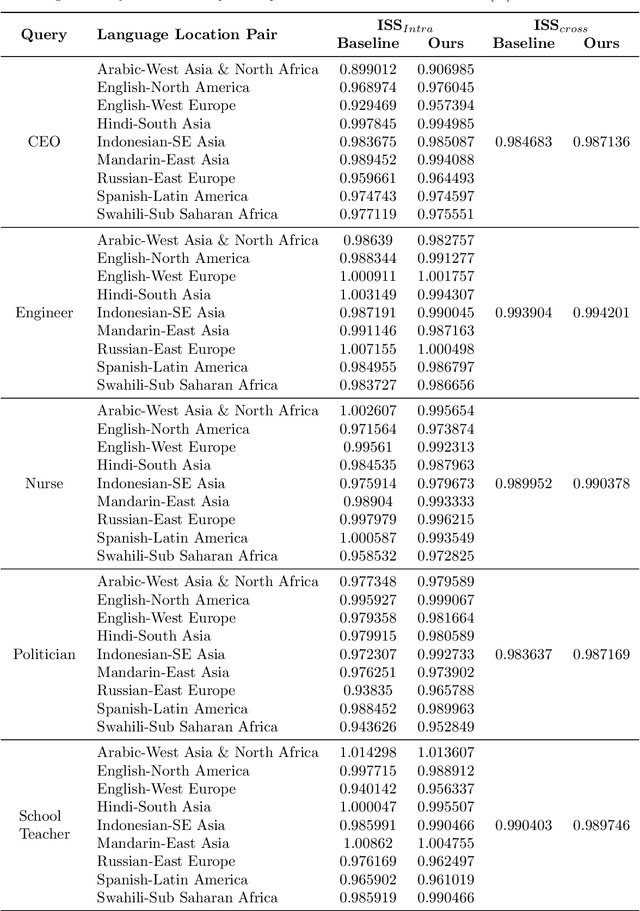
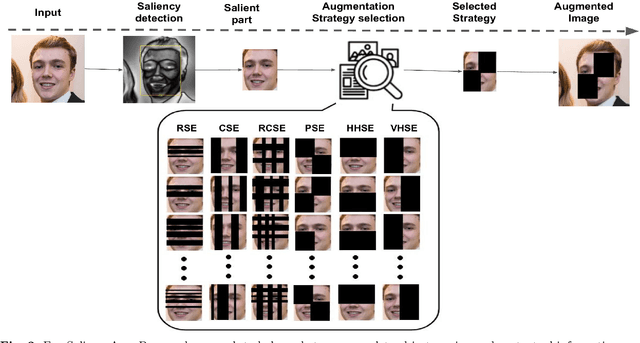
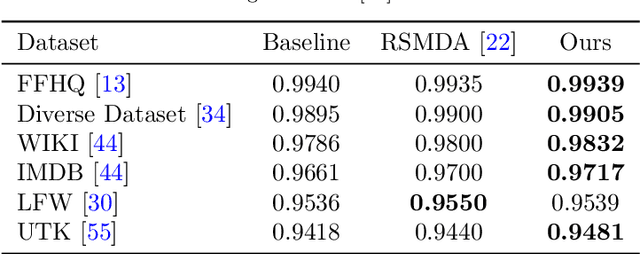
Abstract:Geographical, gender and stereotypical biases in computer vision models pose significant challenges to their performance and fairness. {In this study, we present an approach named FaceSaliencyAug aimed at addressing the gender bias in} {Convolutional Neural Networks (CNNs) and Vision Transformers (ViTs). Leveraging the salient regions} { of faces detected by saliency, the propose approach mitigates geographical and stereotypical biases } {in the datasets. FaceSaliencyAug} randomly selects masks from a predefined search space and applies them to the salient region of face images, subsequently restoring the original image with masked salient region. {The proposed} augmentation strategy enhances data diversity, thereby improving model performance and debiasing effects. We quantify dataset diversity using Image Similarity Score (ISS) across five datasets, including Flickr Faces HQ (FFHQ), WIKI, IMDB, Labelled Faces in the Wild (LFW), UTK Faces, and Diverse Dataset. The proposed approach demonstrates superior diversity metrics, as evaluated by ISS-intra and ISS-inter algorithms. Furthermore, we evaluate the effectiveness of our approach in mitigating gender bias on CEO, Engineer, Nurse, and School Teacher datasets. We use the Image-Image Association Score (IIAS) to measure gender bias in these occupations. Our experiments reveal a reduction in gender bias for both CNNs and ViTs, indicating the efficacy of our method in promoting fairness and inclusivity in computer vision models.
KeepOriginalAugment: Single Image-based Better Information-Preserving Data Augmentation Approach
May 10, 2024
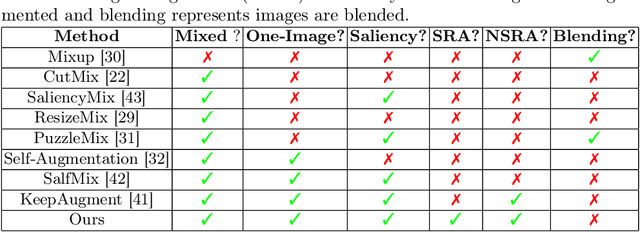

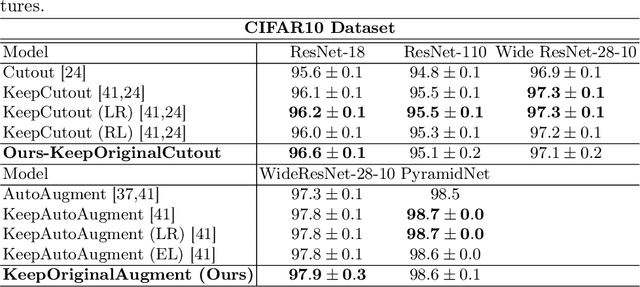
Abstract:Advanced image data augmentation techniques play a pivotal role in enhancing the training of models for diverse computer vision tasks. Notably, SalfMix and KeepAugment have emerged as popular strategies, showcasing their efficacy in boosting model performance. However, SalfMix reliance on duplicating salient features poses a risk of overfitting, potentially compromising the model's generalization capabilities. Conversely, KeepAugment, which selectively preserves salient regions and augments non-salient ones, introduces a domain shift that hinders the exchange of crucial contextual information, impeding overall model understanding. In response to these challenges, we introduce KeepOriginalAugment, a novel data augmentation approach. This method intelligently incorporates the most salient region within the non-salient area, allowing augmentation to be applied to either region. Striking a balance between data diversity and information preservation, KeepOriginalAugment enables models to leverage both diverse salient and non-salient regions, leading to enhanced performance. We explore three strategies for determining the placement of the salient region minimum, maximum, or random and investigate swapping perspective strategies to decide which part (salient or non-salient) undergoes augmentation. Our experimental evaluations, conducted on classification datasets such as CIFAR-10, CIFAR-100, and TinyImageNet, demonstrate the superior performance of KeepOriginalAugment compared to existing state-of-the-art techniques.
AudRandAug: Random Image Augmentations for Audio Classification
Sep 09, 2023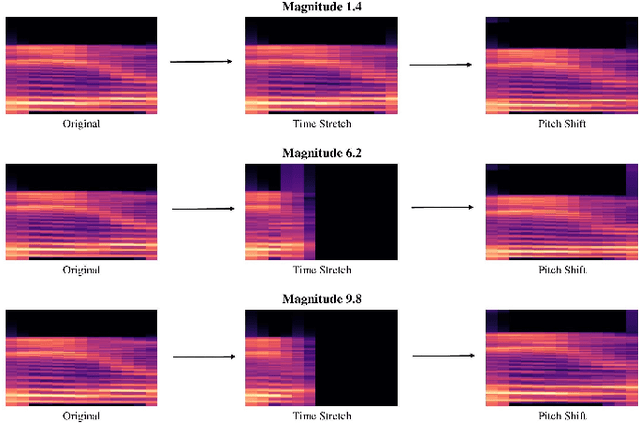
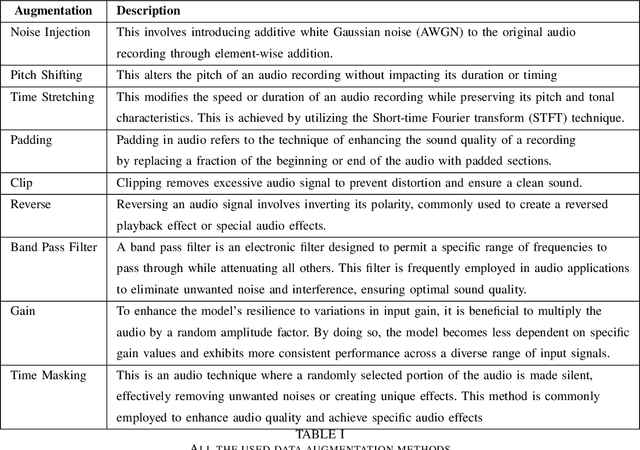
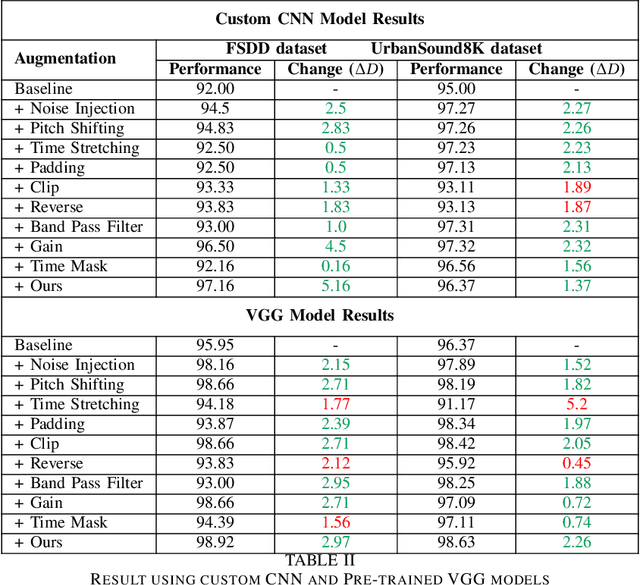
Abstract:Data augmentation has proven to be effective in training neural networks. Recently, a method called RandAug was proposed, randomly selecting data augmentation techniques from a predefined search space. RandAug has demonstrated significant performance improvements for image-related tasks while imposing minimal computational overhead. However, no prior research has explored the application of RandAug specifically for audio data augmentation, which converts audio into an image-like pattern. To address this gap, we introduce AudRandAug, an adaptation of RandAug for audio data. AudRandAug selects data augmentation policies from a dedicated audio search space. To evaluate the effectiveness of AudRandAug, we conducted experiments using various models and datasets. Our findings indicate that AudRandAug outperforms other existing data augmentation methods regarding accuracy performance.
Advanced Data Augmentation Approaches: A Comprehensive Survey and Future directions
Jan 14, 2023



Abstract:Deep learning (DL) algorithms have shown significant performance in various computer vision tasks. However, having limited labelled data lead to a network overfitting problem, where network performance is bad on unseen data as compared to training data. Consequently, it limits performance improvement. To cope with this problem, various techniques have been proposed such as dropout, normalization and advanced data augmentation. Among these, data augmentation, which aims to enlarge the dataset size by including sample diversity, has been a hot topic in recent times. In this article, we focus on advanced data augmentation techniques. we provide a background of data augmentation, a novel and comprehensive taxonomy of reviewed data augmentation techniques, and the strengths and weaknesses (wherever possible) of each technique. We also provide comprehensive results of the data augmentation effect on three popular computer vision tasks, such as image classification, object detection and semantic segmentation. For results reproducibility, we compiled available codes of all data augmentation techniques. Finally, we discuss the challenges and difficulties, and possible future direction for the research community. We believe, this survey provides several benefits i) readers will understand the data augmentation working mechanism to fix overfitting problems ii) results will save the searching time of the researcher for comparison purposes. iii) Codes of the mentioned data augmentation techniques are available at https://github.com/kmr2017/Advanced-Data-augmentation-codes iv) Future work will spark interest in research community.
Understanding EEG signals for subject-wise Definition of Armoni Activities
Jan 03, 2023Abstract:In a growing world of technology, psychological disorders became a challenge to be solved. The methods used for cognitive stimulation are very conventional and based on one-way communication, which only relies on the material or method used for training of an individual. It doesn't use any kind of feedback from the individual to analyze the progress of the training process. We have proposed a closed-loop methodology to improve the cognitive state of a person with ID (Intellectual disability). We have used a platform named 'Armoni', for providing training to the intellectually disabled individuals. The learning is performed in a closed-loop by using feedback in the form of change in affective state. For feedback to the Armoni, an EEG (Electroencephalograph) headband is used. All the changes in EEG are observed and classified against the change in the mean and standard deviation value of all frequency bands of signal. This comparison is being helpful in defining every activity with respect to change in brain signals. In this paper, we have discussed the process of treatment of EEG signal and its definition against the different activities of Armoni. We have tested it on 6 different systems with different age groups and cognitive levels.
Precise Single-stage Detector
Oct 09, 2022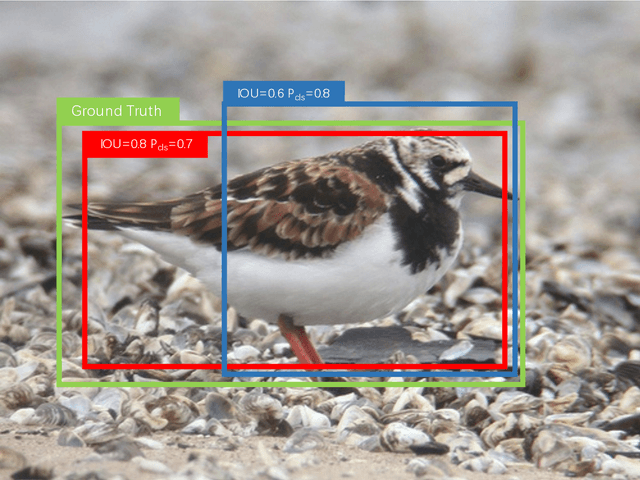
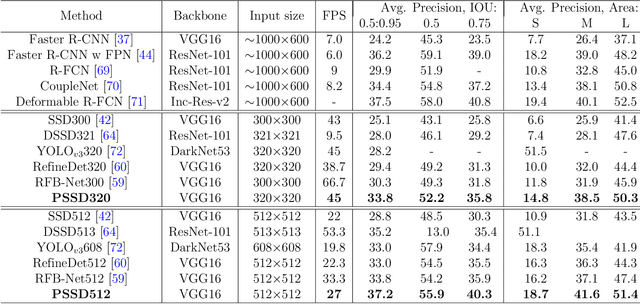


Abstract:There are still two problems in SDD causing some inaccurate results: (1) In the process of feature extraction, with the layer-by-layer acquisition of semantic information, local information is gradually lost, resulting into less representative feature maps; (2) During the Non-Maximum Suppression (NMS) algorithm due to inconsistency in classification and regression tasks, the classification confidence and predicted detection position cannot accurately indicate the position of the prediction boxes. Methods: In order to address these aforementioned issues, we propose a new architecture, a modified version of Single Shot Multibox Detector (SSD), named Precise Single Stage Detector (PSSD). Firstly, we improve the features by adding extra layers to SSD. Secondly, we construct a simple and effective feature enhancement module to expand the receptive field step by step for each layer and enhance its local and semantic information. Finally, we design a more efficient loss function to predict the IOU between the prediction boxes and ground truth boxes, and the threshold IOU guides classification training and attenuates the scores, which are used by the NMS algorithm. Main Results: Benefiting from the above optimization, the proposed model PSSD achieves exciting performance in real-time. Specifically, with the hardware of Titan Xp and the input size of 320 pix, PSSD achieves 33.8 mAP at 45 FPS speed on MS COCO benchmark and 81.28 mAP at 66 FPS speed on Pascal VOC 2007 outperforming state-of-the-art object detection models. Besides, the proposed model performs significantly well with larger input size. Under 512 pix, PSSD can obtain 37.2 mAP with 27 FPS on MS COCO and 82.82 mAP with 40 FPS on Pascal VOC 2007. The experiment results prove that the proposed model has a better trade-off between speed and accuracy.
Random Data Augmentation based Enhancement: A Generalized Enhancement Approach for Medical Datasets
Oct 03, 2022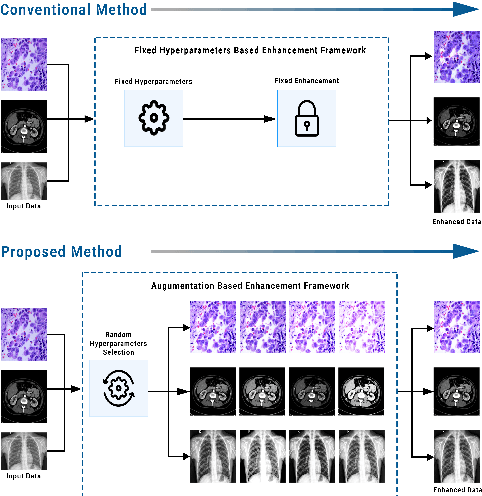



Abstract:Over the years, the paradigm of medical image analysis has shifted from manual expertise to automated systems, often using deep learning (DL) systems. The performance of deep learning algorithms is highly dependent on data quality. Particularly for the medical domain, it is an important aspect as medical data is very sensitive to quality and poor quality can lead to misdiagnosis. To improve the diagnostic performance, research has been done both in complex DL architectures and in improving data quality using dataset dependent static hyperparameters. However, the performance is still constrained due to data quality and overfitting of hyperparameters to a specific dataset. To overcome these issues, this paper proposes random data augmentation based enhancement. The main objective is to develop a generalized, data-independent and computationally efficient enhancement approach to improve medical data quality for DL. The quality is enhanced by improving the brightness and contrast of images. In contrast to the existing methods, our method generates enhancement hyperparameters randomly within a defined range, which makes it robust and prevents overfitting to a specific dataset. To evaluate the generalization of the proposed method, we use four medical datasets and compare its performance with state-of-the-art methods for both classification and segmentation tasks. For grayscale imagery, experiments have been performed with: COVID-19 chest X-ray, KiTS19, and for RGB imagery with: LC25000 datasets. Experimental results demonstrate that with the proposed enhancement methodology, DL architectures outperform other existing methods. Our code is publicly available at: https://github.com/aleemsidra/Augmentation-Based-Generalized-Enhancement
SQL and NoSQL Databases Software architectures performance analysis and assessments -- A Systematic Literature review
Sep 14, 2022
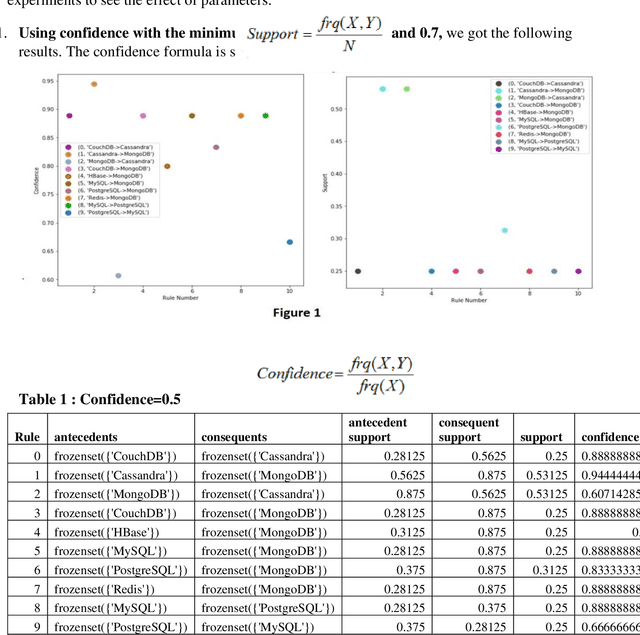

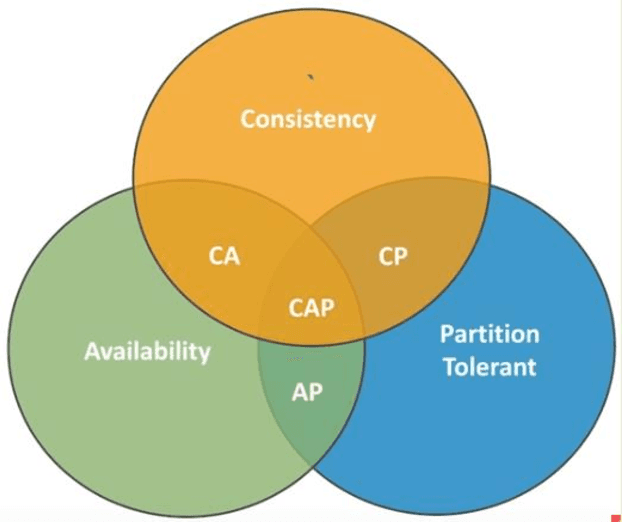
Abstract:Context: The efficient processing of Big Data is a challenging task for SQL and NoSQL Databases, where competent software architecture plays a vital role. The SQL Databases are designed for structuring data and supporting vertical scalability. In contrast, horizontal scalability is backed by NoSQL Databases and can process sizeable unstructured Data efficiently. One can choose the right paradigm according to the organisation's needs; however, making the correct choice can often be challenging. The SQL and NoSQL Databases follow different architectures. Also, the mixed model is followed by each category of NoSQL Databases. Hence, data movement becomes difficult for cloud consumers across multiple cloud service providers (CSPs). In addition, each cloud platform IaaS, PaaS, SaaS, and DBaaS also monitors various paradigms. Objective: This systematic literature review (SLR) aims to study the related articles associated with SQL and NoSQL Database software architectures and tackle data portability and Interoperability among various cloud platforms. State of the art presented many performance comparison studies of SQL and NoSQL Databases by observing scaling, performance, availability, consistency and sharding characteristics. According to the research studies, NoSQL Database designed structures can be the right choice for big data analytics, while SQL Databases are suitable for OLTP Databases. The researcher proposes numerous approaches associated with data movement in the cloud. Platform-based APIs are developed, which makes users' data movement difficult. Therefore, data portability and Interoperability issues are noticed during data movement across multiple CSPs. To minimize developer efforts and Interoperability, Unified APIs are demanded to make data movement relatively more accessible among various cloud platforms.
Investigating Multi-Feature Selection and Ensembling for Audio Classification
Jun 15, 2022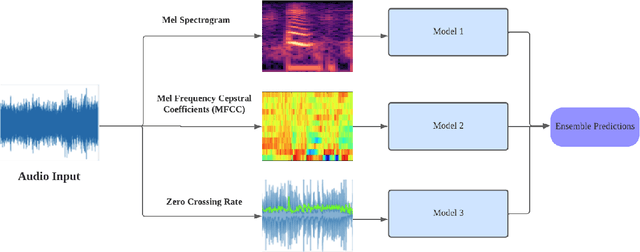
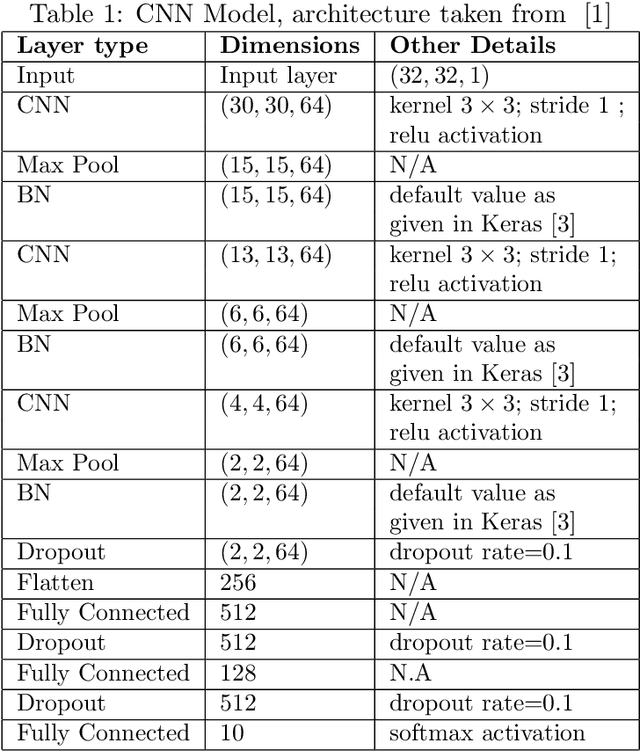
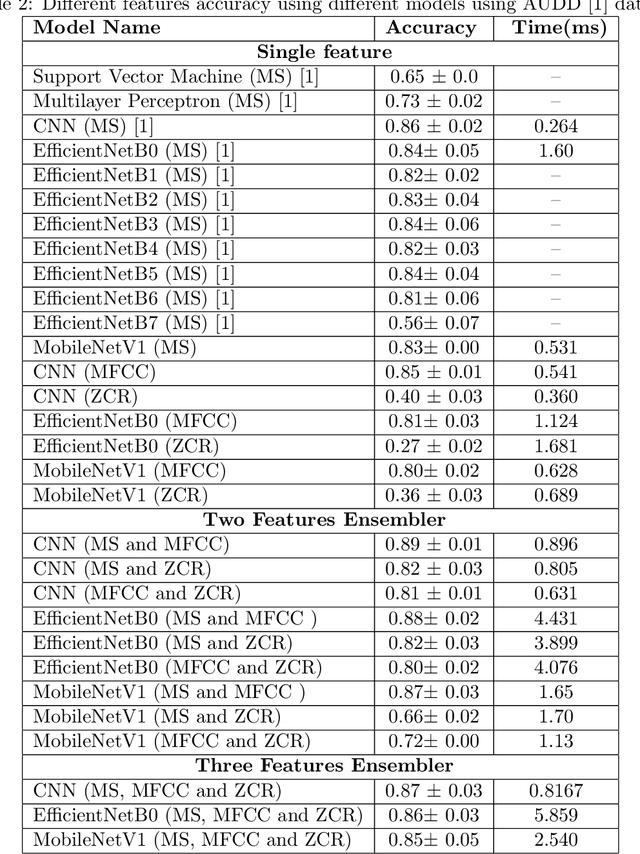
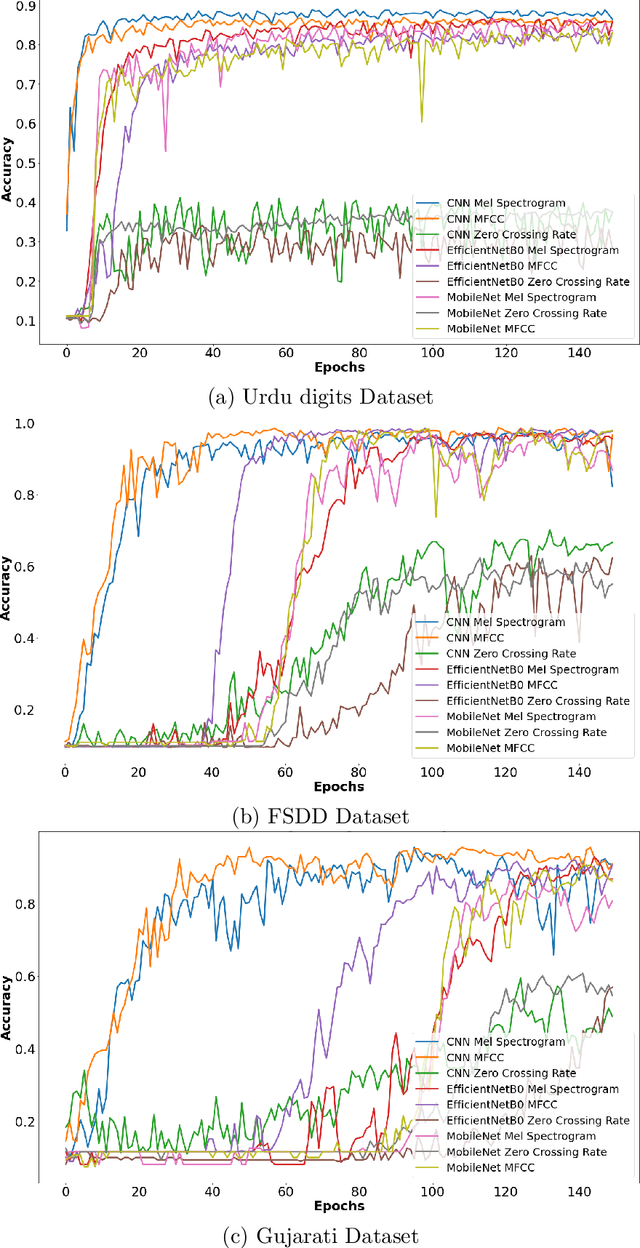
Abstract:Deep Learning (DL) algorithms have shown impressive performance in diverse domains. Among them, audio has attracted many researchers over the last couple of decades due to some interesting patterns--particularly in classification of audio data. For better performance of audio classification, feature selection and combination play a key role as they have the potential to make or break the performance of any DL model. To investigate this role, we conduct an extensive evaluation of the performance of several cutting-edge DL models (i.e., Convolutional Neural Network, EfficientNet, MobileNet, Supper Vector Machine and Multi-Perceptron) with various state-of-the-art audio features (i.e., Mel Spectrogram, Mel Frequency Cepstral Coefficients, and Zero Crossing Rate) either independently or as a combination (i.e., through ensembling) on three different datasets (i.e., Free Spoken Digits Dataset, Audio Urdu Digits Dataset, and Audio Gujarati Digits Dataset). Overall, results suggest feature selection depends on both the dataset and the model. However, feature combinations should be restricted to the only features that already achieve good performances when used individually (i.e., mostly Mel Spectrogram, Mel Frequency Cepstral Coefficients). Such feature combination/ensembling enabled us to outperform the previous state-of-the-art results irrespective of our choice of DL model.
 Add to Chrome
Add to Chrome Add to Firefox
Add to Firefox Add to Edge
Add to Edge